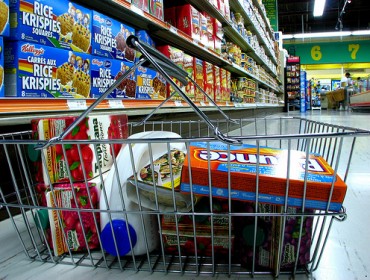
SNAP to it Food Stamp Challenge–Day Six
By Sharron R. Blezard, June 6, 2010
Day six of the SNAP to it Challenge passed by without event, complaint, or the spending of money. I call that a successful day! We ate well, and there is still plenty of food variety in the Lucas pantry. I don’t anticipate having to shop until the middle of the week at the earliest.
One of the things that struck me today is how lucky I am to be able to shop at a variety of stores. The closest one to me is GreenLife (just bought out by Whole Foods). I really like GreenLife, and it’s within walking/biking distance, but this month probably won’t see me darkening their door very much because of the expense. Within a five or six mile radius are two BiLo Stores (owned by a large French corporation), a Sav-a-lot outlet, and a Super WalMart. There is a small farmers’ market/produce stand and a large weekly farmer’s market downtown. If I wanted to drive 10-12 miles, I could have my choice of Publix, Fresh Market, World Market, Aldi, or Earth Fare. It’s almost obscene to have this much variety when it comes to grocery shopping.
On the other hand, when I lived in North Dakota, the grocery options were pretty limited. The little town where I lived had a convenience store/gas station/supply store where you could get light bread, milk, bacon, bologna, pop, eggs, and a few other items like frozen pizza, pre-made sandwiches, candy, and chips. The nearest mom-and-pop grocery was 10 miles away. It was a small store that did offer decent variety, but the fresh produce was limited and expensive. Otherwise it was 25 or 30 miles to a bigger regional store. To get to a Super Target, Sam’s Club or national chain, one had to drive 1.5 to 3 hours. For people on limited incomes or without reliable transportation it was a pretty tough situation. Our little town did start a farmers’ market, and the mobile food pantry stopped each quarter. There were also food pantries 10 and 25 miles away.
Americans spend a relatively small percentage of income on food. Food is pretty cheap in our country, and for most of us it’s pretty plentiful and the access is good. Not so in many other nations. The variety we enjoy here is unheard of for the majority of the world’s people. Have you ever stopped to think about what it takes to get your cheap food into your hands? What about the fuel costs of delivering that banana from Central America, the salmon from Thailand, and your little oranges from Spain? We have access to so much, so inexpensively, and yet we still deal with shocking levels of hunger and poverty, poor nutrition from all of the junk food and overly processed convenience options, and here’s a new term I learned today—food deserts.
![2902858861_d5b13a7b4a_m[1]](http://www.stewardshipoflife.org/wordpress/wp-content/uploads/2010/06/2902858861_d5b13a7b4a_m1.jpg) Yes, that’s right, forget the Mohave, we have food deserts across our nation from Mississippi to North Dakota. There are many places in America where access to good food is absent or severely limited: from inner city neighborhoods without groceries to rural areas where fields sown with crops destined for export or processing surround dying towns without access to healthy food. Go figure!
Yes, that’s right, forget the Mohave, we have food deserts across our nation from Mississippi to North Dakota. There are many places in America where access to good food is absent or severely limited: from inner city neighborhoods without groceries to rural areas where fields sown with crops destined for export or processing surround dying towns without access to healthy food. Go figure!
So how in the world do we begin to take a bite out of such a huge problem? Is it possible to make a difference? The answer, of course, is yes, but it won’t be easy. The solution lies in working one community at a time, offering education, getting to know our neighbors, and refusing to be party to the systems that keep such inequity in place. It may mean passing that banana by in favor of a locally grown apple or bunch of grapes. It may mean being willing to buy locally from small farmers, or promoting healthy foods in your local school. Good food and enough of it should be a right, not a privilege. What do you think?
State of the Pantry
Today I was running late for church, so I ate the last granola bar and drank a cup of coffee on the run. For lunch I had the leftovers from Applebees and some watermelon. For afternoon snack I had a cheese stick and an apple. Supper was homemade cheesy potato soup and a big salad. In addition to the morning coffee, green tea and water were the beverage choices of the day.
Website of the Day
![]() Today’s website is from PBS NewsHour, particularly a link to a story entitled “Mississippi Food Deserts Fuel Obesity.†I again thank one of my Compact compatriots for this link. Click here to view this short, eye-opening video!
Today’s website is from PBS NewsHour, particularly a link to a story entitled “Mississippi Food Deserts Fuel Obesity.†I again thank one of my Compact compatriots for this link. Click here to view this short, eye-opening video!
Grocery Cart Creative Commons Photo Credit: http://www.flickr.com/photos/qmnonic/218410335/
Church Hill, Mississippi Creative Commons Photo Credit: Natalie Maynor http://www.flickr.com/photos/nataliemaynor/2902858861/
About the Author
The Rev. Sharron Riessinger Blezard is an ELCA pastor currently rostered in the Lower Susquehanna Synod. She came to ordained ministry after teaching secondary and college English, working in non-profit management and public relations, and moonlighting as a freelance writer. See more posts by Sharron R. Blezard.
Stewardship of Life
Thank you for printing this article!
You can view this article online at http://bit.ly/aHSKMQ.
© 2010 Stewardship of Life Institute
https://westrevision.stewardshipoflife.org



